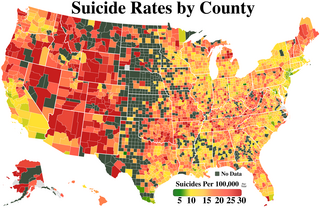
Homicide is an act in which a person causes the death of another person.
A violent crime, violent felony, crime of violence or crime of a violent nature is a crime in which an offender or perpetrator uses or threatens to use harmful force upon a victim. This entails both crimes in which the violent act is the objective, such as murder, assault, rape and assassination, as well as crimes in which violence is used as a method of coercion or show of force, such as robbery, extortion and terrorism. Violent crimes may, or may not, be committed with weapons. Depending on the jurisdiction, violent crimes may be regarded with varying severities from homicide to harassment. There have been many theories regarding heat being the cause of an increase in violent crime. Theorists claim that violent crime is persistent during the summer due to the heat, further causing people to become aggressive and commit more violent crime.
Crime has been recorded in the United States since its founding and has fluctuated significantly over time, with a sharp rise after 1900 and reaching a broad bulging peak between the 1970s and early 1990s. After 1992, crime rates have generally trended downwards each year, with the exceptions of a slight increase in property crimes in 2001 and increases in violent crimes in 2005-2006, 2014-2016 and 2020-2021. While official federal crime data beginning in 2021 has a wide margin of error due to the incomplete adoption of the National Incident-Based Reporting System by government agencies, federal data for 2020-2021 and limited data from select U.S. cities collected by the nonpartisan Council on Criminal Justice showed significantly elevated rates of homicide and motor vehicle theft in 2020-2022. Although overall crime rates have fallen far below the peak of crime seen in the United States during the late 1980s and early 1990s, the homicide rate in the U.S. has remained high, relative to other "high income"/developed nations, with eight major U.S. cities ranked among the 50 cities with the highest homicide rate in the world in 2022. The aggregate cost of crime in the United States is significant, with an estimated value of $4.9 trillion reported in 2021. Data from the first half of 2023, from government and private sector sources show that the murder rate has dropped, as much as 12% in as many as 90 cities across the United States. The drop in homicide rates is not uniform across the country however, with some cities such as Memphis, TN, showing an uptick in murder rates.

Gun violence is a term of political, economic and sociological interest referring to the tens of thousands of annual firearms-related deaths and injuries occurring in the United States. In 2022, up to 100 daily fatalities and hundreds of daily injuries were attributable to gun violence in the United States. In 2018, the most recent year for which data are available, the Centers for Disease Control and Prevention's (CDC) National Center for Health Statistics reported 38,390 deaths by firearm, of which 24,432 were suicides. The national rate of firearm deaths rose from 10.3 people for every 100,000 in 1999 to 11.9 people per 100,000 in 2018, equating to over 109 daily deaths. In 2010, there were 19,392 firearm-related suicides, and 11,078 firearm-related homicides in the U.S. In 2010, 358 murders were reported involving a rifle while 6,009 were reported involving a handgun; another 1,939 were reported with an unspecified type of firearm. In 2011, a total of 478,400 fatal and nonfatal violent crimes were committed with a firearm.

Gun-related violence is violence committed with the use of a firearm. Gun-related violence may or may not be considered criminal. Criminal violence includes homicide, assault with a deadly weapon, and suicide, or attempted suicide, depending on jurisdiction. Non-criminal violence includes accidental or unintentional injury and death. Also generally included in gun violence statistics are military or para-military activities.

This is a list of US states by gun deaths and rates of violence. In 2021, there were 26,000 gun suicides and 21,000 gun homicides, together making up a sixth of deaths from external causes. Gun deaths make up about half of all suicides, but over 80% of homicides.

In 2018, the Small Arms Survey reported that there are over one billion small arms distributed globally, of which 857 million are in civilian hands. The survey stated that American civilians account for an estimated 393 million of the worldwide total of civilian held firearms, or about 120.5 firearms for every 100 American residents.
An occupational fatality is a death that occurs while a person is at work or performing work related tasks. Occupational fatalities are also commonly called "occupational deaths" or "work-related deaths/fatalities" and can occur in any industry or occupation.
In 2019, 43,686 crimes were reported in the U.S. state of Michigan. Crime statistics vary widely by location. For example, Dearborn has a murder rate of only 2.1 per 100,000 while sharing borders with Detroit and Inkster, some of the highest rates in the state.

Suicide is a major national public health issue in the United States. The country has one of the highest suicide rates among wealthy nations. In 2020, there were 45,799 recorded suicides, up from 42,773 in 2014, according to the CDC's National Center for Health Statistics (NCHS). On average, adjusted for age, the annual U.S. suicide rate increased 30% between 2000 and 2020, from 10.4 to 13.5 suicides per 100,000 people. In 2018, 14.2 people per 100,000 died by suicide, the highest rate recorded in more than 30 years. Due to the stigma surrounding suicide, it is suspected that suicide is generally underreported. In April 2016, the CDC released data showing that the suicide rate in the United States had hit a 30-year high, and later in June 2018, released further data showing that the rate has continued to increase and has increased in every U.S. state except Nevada since 1999. From 2000 to 2020, more than 800,000 people died by suicide in the United States, with males representing 78.7% of all suicides that happened between 2000 and 2020. In 2022, a record high 49,500 people died by suicide, while the suicide rate in 2022 reached its highest level since 1941 at 14.3 per 100,000 persons. Surging death rates from suicide, drug overdoses and alcoholism, what researchers refer to as "deaths of despair", are largely responsible for a consecutive three year decline of life expectancy in the U.S. This constitutes the first three-year drop in life expectancy in the U.S. since the years 1915–1918.
Murder in Ohio law constitutes the unlawful killing, under circumstances defined by law, of people within or under the jurisdiction of the U.S. state of Ohio.
In the United States, use of deadly force by police has been a high-profile and contentious issue. In 2022, 1,096 people were killed by police shootings according to The Washington Post, while according to the "Mapping Police Violence" (MPV) project, 1,176 people were killed by police in total. MPV documented 1,213 killings by police for 2023.

The United States Centers for Disease Control and Prevention has data on drug overdose death rates and totals. Around 1,106,900 US residents died from drug overdoses from 1968 to 2020, around 932,400 from 1999 through 2020 and around 91,800 in 2020. Of every 100,000 people in 2020 in the US, drugs killed 28. Opioids were involved in around 80,400 of the around 106,700 deaths in 2021. Synthetic opioids other than methadone were involved with 70,601 deaths in 2021.
Murder in Alabama law constitutes the intentional killing, under circumstances defined by law, of people within or under the jurisdiction of the U.S. state of Alabama.
Murder in Colorado law constitutes the unlawful killing, under circumstances defined by law, of people within or under the jurisdiction of the U.S. state of Colorado.
Murder in Texas law constitutes the intentional killing, under circumstances defined by law, of people within or under the jurisdiction of the U.S. state of Texas.

The Bipartisan Background Checks Act is a proposed United States law that would establish new background check requirements for firearm transfers between private parties. It would prohibit a firearm transfer between private parties until a licensed gun dealer, manufacturer, or importer conducts a successful background check.
Murder in Delaware law constitutes the unlawful killing, under circumstances defined by law, of people within or under the jurisdiction of the U.S. state of Delaware.
Murder in Illinois law constitutes the intentional killing, under circumstances defined by law, of people within or under the jurisdiction of the U.S. state of Illinois.
Murder in Missouri law constitutes the killing, under circumstances defined by law, of people within or under the jurisdiction of the U.S. state of Missouri.










